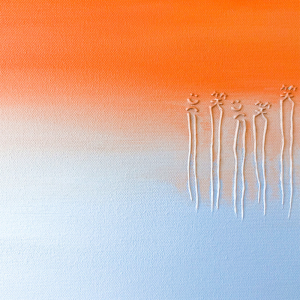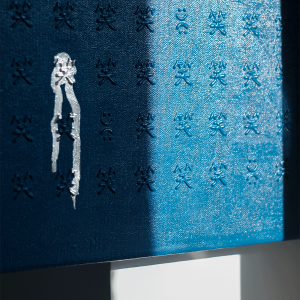Diversity in Ink: Asian Heritage x Contemporary Art
Words by: Nissa Kauppila, TTS, Parkg, and Krizia Li
In honor of Hong Kong's Art Month, Vermillion has curated Asia's contemporary ink artists from 3 different perspectives to illustrate the diverse aesthetic styling and philosophical approaches to a traditional medium.

From our artists portfolio, we interviewed Nissa from Vermont in the United States, TTS from the United Kingdom and Hong Kong, alongside Parkg Studio from South Korea.
When you first started creating art, what specifically drew you to your chosen classical art form, medium or technique?
Nissa: I started creating art from as early on as I can remember—it’s something that’s been ingrained in me for as long as I could hold a pencil, a paintbrush, or use my hands. I have always been drawn to painting throughout my life, (amidst a variety of other art mediums), but in particular, gouache and watercolor have been a chosen medium due to the ability to create fine detail on one end of the spectrum, to washes of pigment with little form on the other. Both fine detail and the ethereal feeling of color washes provides an array of emotions and feelings, dependent on myself at the time of conceiving the art piece, as well as the viewer when taking it in.
TTS: I have always been a ceramist, hence, working with clay and using it as my canvas. When I started painting again, I was just taking a small break from ceramic creations and I instantly became attracted to painting, the direct contact with paint, canvas and brushes, has an incredible appeal for me.
Parkg: I've been working with a variety of materials since I was a child, and in college, I studied and worked on traditional and classical materials, like ink, Korean paper, gold leaf, etc. So I naturally chose to use the traditional materials when I started working on “A Little Talk” series because I believed that the most classical and traditional could be modern.
 100 Smiles Art Prints No. 04 by TTS Art
100 Smiles Art Prints No. 04 by TTS Art
How did you develop your core creative concept in order to best complement your signature artistic medium or technique?
Nissa: I grew up in the very rural environment of northern Vermont, in the United States, on a lake, tucked between mountain ranges, rivers, and the like. The natural world was at my disposal in terms of finding inspiration—I spent my childhood outdoors, adventuring, exploring, and being continuously curious about the fauna and flora around me. In thinking about classical Chinese paintings and techniques, there is a familiarity there in the honoring of the natural world through the use of varying brush strokes, simplicity, what’s left unsaid or absent. For reasons I cannot explain, having never studied traditional Chinese painting techniques before, I seemed to encapsulate a similar style in my work which also revolves around the wonderment and love of the natural world.
TTS: It is hard to unpack the creative process briefly because it isn’t the same for each painting. I have always been fascinated by the concept of happiness, it is a complex emotion that many of us search for in our lives and this idea has always been the generative spark of my work. My love for Chinese art and ceramics undoubtedly inspire me how I create my works, all of these feed my creative process consciously and subconsciously, such as the choice of colors and textural elements you can see constantly in my artworks.
Parkg A while ago, I was anxious about the uncertainty of the future and embarked on my first solo journey. While exploring different parts of a city in complete anonymity, I often felt conflicting emotions (overwhelmingness – emptiness, loneliness - exhilaration, heaviness – lightness). After returning from my trip, I decided to carry on with my work. To illustrate the contradictory emotions such as East - West, boldness - precision, fullness - emptiness and distortion - balance, I applied ink and materials from both the East and the West to destroy and divide the pictorial space while maintaining a balance in between. A contrast of black ink on white Korean paper with a city scene within. The boldly filled space reflects the fleeting solitude and thrill of the moment whilst the detailed portrayal of the city is what I saw with my eyes.
 A Little Talk (Hong Kong II) by Parkg Studio
A Little Talk (Hong Kong II) by Parkg Studio
How did you train yourself to excel within this artform?
Nissa: My art is what brought me to mainland China originally. I had been invited to visit Shanghai many years back to meet with some of the galleries and art professionals in that particular art scene and then made the decision to develop my style and art by spending a year in southern China back in 2015, immersing myself not only in the access to materials foreign to me at the time (rice paper, Chinese inks, etc.), but also in the local arts scene. I have since called Southern China, and Hong Kong, home. I hadn’t originally set out to move fully towards using all traditional materials at the time, but found a connection to these once trying on my own and then meeting a variety of artists in Foshan, China, who welcomed me into their artist circles and studios. I dove into spending as much time in my studio, practicing with a variety of papers, pigments, techniques, etc.
TTS: Art is a tool to help me engage with myself and the world I’m in today. I harness the power of monochrome and duo-color, scale and repetition in my artworks which calls for self-analysis and questioning our own existence. Being an ancient Chinese ceramics enthusiast, the monochrome glazed ceramic wares in particular influenced the color palette of my artworks. The concept of ‘white space’ in traditional Chinese aesthetics is also important to me. The literal text and motifs created by repetition become pure textural and tactile elements on monochrome canvas. It is a manifestation of being and non-being.
Parkg: I need a lot of time to complete one artwork. In order to express the details of the cityscape, I devote a certain amount of time into my work everyday. To me, the key to excel is consistency. “The act of creating is like a ritual of serene meditation in which I can find a balance in the world without being swayed by it.”
How would you describe the execution challenges vs the joys of leveraging your artform of choice?
Nissa: One of the big challenges for me is the fact that working with traditional Chinese materials, such as rice paper, various brushes and paints / inks, requires almost a network of participants that people don’t fully realize or understand. When I finish a painting, this is only one step in the entire process; it must also be mounted in the traditional Chinese style of utilizing rice adhesives and the layering of multiple rice papers and silk, which involves a group of people, and can take up to a week to accomplish. Materials need to be ordered ahead of time (specialty rice paper of varying sizes), work needs to be scanned after mounting, and then framed or scrolled. It’s a group effort that one must be in tune with and flexible with. For me, this was a learning curve that I fully appreciate and embrace, and in fact makes the finalized paintings that much more special and unique.
TTS The process of painting the character「笑」‘Smile’ and upward-downward smiley face motifs repetitively often takes weeks and even months. It is a ritualistic and meditative journey. Through this period, my emotions change but I am tasked with staying focused while painting with emotions that are not visible on the canvas, and they supported me from going through the long painting process. Having an intimate relationship with every single artwork I create, I would say essentially, paintings are collections of what I am / was going through, be it visible or not.
Parkg: Yes. I really enjoy challenging various techniques and materials. Challenges always start unpredictably, but they eventually lead to another result by finding balance. Recently, I started working on ceramics and ottchil hanji, and I think the “A Little Talk” series is slowly changing with new challenges.
 Art Basel Hong Kong shaping up to be biggest in years, with 242 exhibitors signed up. Photo credit: South China Morning Post
Art Basel Hong Kong shaping up to be biggest in years, with 242 exhibitors signed up. Photo credit: South China Morning Post
How are you evolving your art constantly over time to present something new and interesting to your fans?
Nissa: I have been working towards involving myself more in connecting directly with nature conservation groups and animal rescue and rehabilitation centers around the world to draw inspiration around my themes (wildlife) in an effort to appreciate the on-going conservation efforts and bring more awareness to the fragility of the natural world. I have also been working with testing the traditional materials I currently use in how they can be implemented in ways not before seen or used, which is an on-going process, so stay tuned!
TTS: I stay opened-minded, give in and allow myself to explore. Sometimes, I switch tools and experiment, just following my gut and my obsessions wherever they lead me.
Parkg: I am constantly exploring materials and traveling to new destinations. I believe that the more I travel the more I’ll be able to share my memories and emotions through my work.

 HK$
HK$ SG$
SG$





















